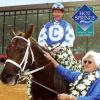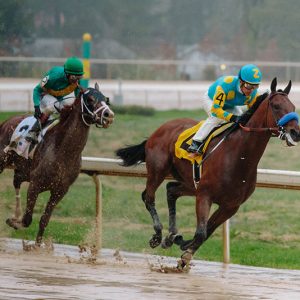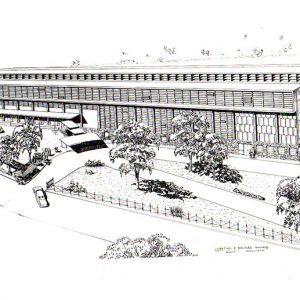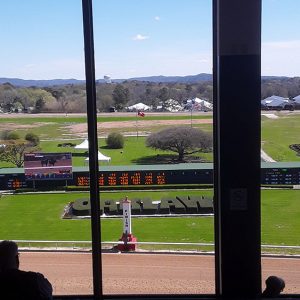calsfoundation@cals.org
Oaklawn Racing Casino Resort
aka: Oaklawn Park Racetrack
aka: Oaklawn Jockey Club
aka: Oaklawn Racing and Gaming
Even before the Civil War, the former pasture where Oaklawn Racing Casino Resort now stands in Hot Springs (Garland County) was home to impromptu races between local farm boys riding their fastest ponies. Today, the track is Arkansas’s only thoroughbred horse racing venue and the lone remaining gambling center in a city once known as much for its casinos as for its famous thermal baths.
The popularity of Sportsman’s Park, built on the southeastern edge of Hot Springs in the early 1890s, sparked an interest in developing the sport of thoroughbred horse racing in the area. Following the 1903 repeal of anti-gambling laws, Essex Park was built in 1904. Charles Dugan, Dan Stuart, and John Condon—owners of the Southern Club—decided to build a racetrack on a site closer to downtown. In 1904, they formed the Oaklawn Jockey Club and began construction shortly afterward. The name “Oaklawn” came from the rural community in which the track would be built, which in turn took its name from what Peter LaPatourel, an early settler to the area, called his home, around which a large stand of ancient oaks stood. Oaklawn Park opened on February 15, 1905, and prevailed as the lone remaining horse-racing venue by 1907. The original venue reportedly cost $500,000 and could seat 1,500 spectators. It included innovations such as a glass-enclosed grandstand and steam heat—one of the first racetracks in the country with either.
Anti-gambling sentiments, driven by former Essex Park owner and former state legislator from Garland County William McGuigan, rose in the form of a bill entitled “An Act to Prevent Betting in any Manner in This State on any Horse Race.” The bill was approved by the state government on February 27, 1907, and necessitated the closing of Oaklawn Park at the end of the 1907 season and for a decade after that. The infield of the track continued to be used for other purposes and was the site of the Arkansas State Fair beginning in 1906 and continuing through 1914, including a 1910 fair that was attended by former president Theodore Roosevelt.
By 1914, Oaklawn was owned by Louis A. Cella and his brother Charles, both of St. Louis, Missouri. The track has remained in the Cella family since then. In 1915, a bill to legalize horse racing and pari-mutuel betting , a system in which all bets are pooled and winners are paid based on odds established before each race, had passed both houses of the legislature but was vetoed by Governor George Washington Hays. The veto was challenged in the courts by local citizens but was eventually affirmed by the Arkansas Supreme Court.
The aftermath of fires in 1913 caused a downturn in tourism in Hot Springs, fueled by rumors that the city could not accommodate guests as a result of the damage. The persistence of these rumors inspired city leaders to find a way to draw tourists back to the city. In 1916, the Hot Springs Men’s Business League reopened Oaklawn Park by setting a short racing schedule beginning on March 11 under the guise of a nonprofit civic enterprise. Pari-mutuel betting was not allowed, but this did not preclude any unofficial wagering. This thirty-day season was a success and led to the reopening of both Oaklawn Park and Essex Park the following year, with plans for the two tracks to split a full season. Unfortunately, the newly refurbished Essex Park burned the day after its grand reopening in 1917, thus moving the entire season to Oaklawn and marking the end of racing at Essex permanently.
Pending litigation and the Men’s Business League sponsorship, along with the banning of pari-mutuel betting, had allowed Oaklawn Park to continue to have races until 1919, when Circuit Judge Scott Wood put forth the opinion that continuing to hold the races was illegal, and the track was again closed. In 1929, another bill made it through both the Arkansas House and Senate only to be vetoed, this time by Governor Harvey Parnell.
Attempts to pass legislation to permit pari-mutuel betting on horse races in 1931 and 1933 both failed, but in 1934, a group of prominent Hot Springs citizens and businessmen, including Mayor Leo P. McLaughlin, formed the Business Men’s Racing Association and announced that races would be held in March of that year. The move was inspired by growing national interest in the sport of thoroughbred racing and the need to draw more visitors to the city. On March 1, 1934, Oaklawn reopened to a crowd of 8,000 spectators without the consent of the legislature. Future legal ambiguity was avoided in 1935 with the passage of a bill to permit horse racing with pari-mutuel wagering. This time, the bill was signed into law by Governor Junius M. Futrell.
According to Oaklawn Park history, the first Arkansas Derby ran in 1936 with a purse of $5,000. The derby is the most prestigious race regularly held at Oaklawn Park and is considered a preliminary for contenders at the highest levels of national thoroughbred horseracing. Several participants in the Arkansas Derby, such as Smarty Jones and Count Fleet, have gone on to compete in and win some or all of the races that make up the Triple Crown.
Attendance at the track increased yearly, and in 1961, the thirty-day season was increased to forty-three days. By 1984, the racing season at Oaklawn Park had increased to sixty-two days a year, following steady increases in attendance and wagering, but the following years witnessed the first declines at the track in many years. This, coupled with the legalization of riverboat gambling in nearby Mississippi and Louisiana, led track leadership to explore ways to supplement Oaklawn’s income and help fund more competitively lucrative purses during the live racing season. This effort was aided by 1989 legislation to legalize simulcast or off-track betting and to allow for a public referendum on Sunday racing. Shortly thereafter, Oaklawn began offering betting on races from other tracks during its off season as well as during the live season. Sunday racing was also passed, and in 1989, the first Sunday racing at Oaklawn Park was held.
Continuing to press for additional sources of income to counter the growing impact of competition, Oaklawn leadership was given some additional relief by the Arkansas legislature in 1999 when “instant racing” was approved as a legal form of gambling. Instant racing involves a machine, much like a slot or video poker machine, which allows the player to bet on the outcomes of previously run horse races. These races are viewed in the form of digital videos that are played on the machine once the player has placed a bet. Instant racing was first tested at Oaklawn Park and has become increasingly popular nationwide as a way of providing electronic gaming where live racing is already legal. With the 2005 passage of another public referendum allowing so-called “games of skill” at Oaklawn and Southland Greyhound Park in West Memphis (Crittenden County), video poker was added to the gambling options available at Oaklawn year round. This later expanded into a range of casino offerings.
Throughout Oaklawn’s history, the facilities have been regularly improved and expanded to serve greater numbers of patrons and accommodate changes in the business. Expansions and additions during the latter half of the twentieth century increased the size of the facility and improved available amenities. In 1992, the largest hand-crafted artwork at any thoroughbred racetrack in the country was completed on the front façade of Oaklawn. The mural, which measures 240 feet by fourteen feet, represents a race from post parade to the finish and can be seen along the upper edge of the building over the main or southernmost entrance. After 2000, the expansion of electronic gaming demanded more space, requiring the conversion of areas previously dedicated to live racing on the lower level at the south end of the facility. This area has evolved into what is now a self-contained electronic gaming area, complete with its own restaurant.
Long-serving Oaklawn president Charles J. Cella became president in 1968 after the death of his father, John. Oaklawn celebrated its centennial year in 2004 with increases in both attendance and in money wagered. In 2005, Oaklawn Park and the Cella family were awarded an Eclipse Award of Merit, the most prestigious award in racing, by the National Thoroughbred Racing Association, in association with the Daily Racing Form and the National Turf Writers Association. The award was given in recognition of increases in attendance and wagering at the track over the previous five years running. Oaklawn is the first racetrack in the country to receive an Eclipse Award. After the death of Charles Cella in 2017, Louis Cella, his son, was named president.
In 2018, following voter approval of a referendum to expand legal gambling in the state, Oaklawn announced plans for a $100 million hotel and event center at the track site. The following year saw changes to the race schedule, including the addition of an opening day race, the Smarty Jones Stakes, designated as preparatory for the Kentucky Derby, as well as the extension of the racing schedule three weeks beyond the Arkansas Derby. In 2019, the name was changed to Oaklawn Racing Casino Resort.
For additional information:
Anthony, Isabel Burton. “Happy Birthday Oaklawn Jockey Club: Oaklawn Park Celebrates a Century of Thoroughbred Racing.” The Record 45 (2004): 1–15.
Brown, Dee A. The American Spa: Hot Springs Arkansas. Little Rock: Rose Publishing Company, 1982.
Lancaster, Bob. “Oaklawn Reincarnated as Simulcasting City.” Arkansas Times, July 28, 1995, pp. 11–12.
Nelson, Rex. “There’s More Than One Way to Race: The Evolution of Oaklawn Park.” The Record 56 (2015): 12.1–12.12.
“Oaklawn 1990.” Special section, Arkansas Times, February 1990.
Oaklawn Racing Casino Resort. http://www.oaklawn.com/ (accessed January 18, 2023).
Perkins, Pete. “And So It Begins.” Arkansas Democrat-Gazette, January 25, 2019, pp. 1C, 4C.
“Post Time!” Special section, Arkansas Times, February 1989.
Scully, Francis J. Hot Springs, Arkansas and Hot Springs National Park. Little Rock: Pioneer Press, 1966.
Michael Hodge
North Little Rock, Arkansas























It’s a spectacular and exciting place to visit and stay. I try to go at least twice a year as an out-of-state visitor. The town of Hot Springs is equally one of my favorite places to visit.